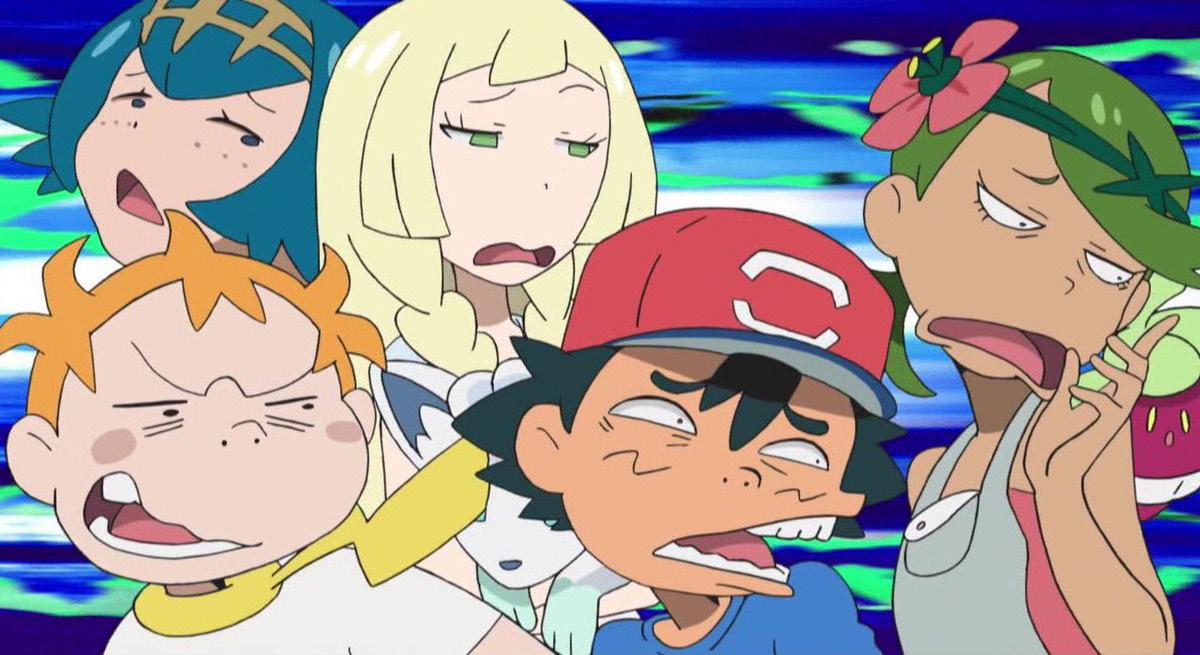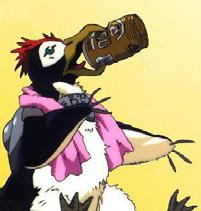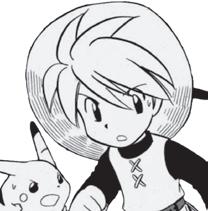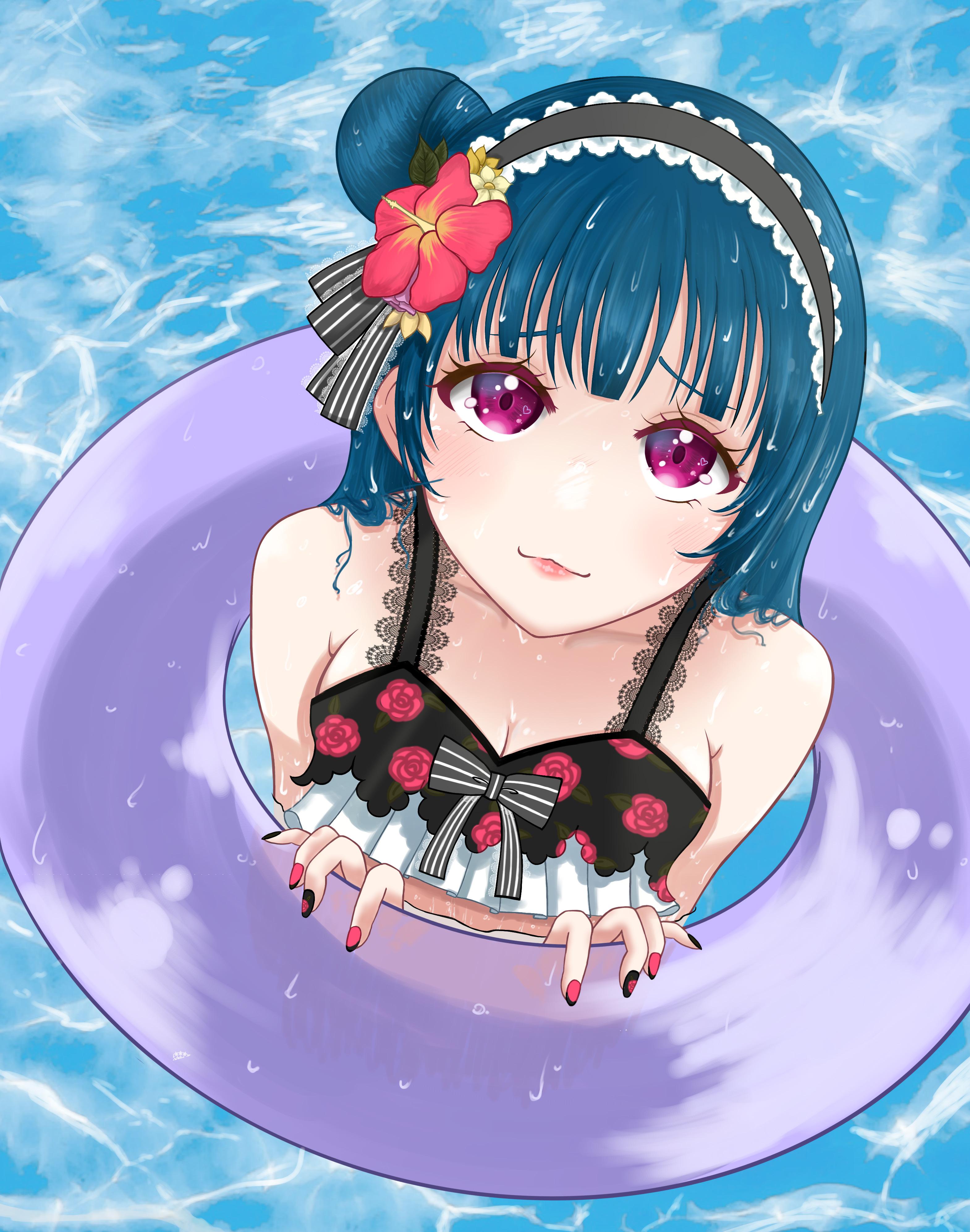Original Characters
Underwater


Underwater

After an epic but somewhat disappointing finale to the XY series, Pokémon Sun & Moon takes on a completely different tone and pace as Ash attends school in the goofy and carefree Alola region. There’s always fun under the Alolan sun with Ash and his new group of friends, acting as a nice break from the more serious plot lines from previous seasons.


 BY MITCHELL MADAYAG
BY MITCHELL MADAYAG
Nothing fits an Underwater Issue recommendation better than an anime all about swimming. The expected themes of competition and camaraderie are of course emphasized, but Free! excels beyond being just a sports anime with its occasional lighthearted slice of life moments. With superb animation and a great soundtrack that most KyoAni shows are known for, Free! will be a great show to watch this upcoming summer.

 by Cas Geiger
by Cas Geiger
 Hatsune Miku
Vocaloid
Hatsune Miku
Vocaloid
still one of the most magical and well constructed moments I have seen in any film. Not dissimilar to what I previously wrote about My Neighbor Totoro, Ponyo’s greatest strength is this ephemeral mystique conveyed via stellar audiovisual presentation.
One of my earlier memories of a disconnect between general consensus and my own personal views on a piece of media was the 2008 Studio Ghibli film, Ponyo. For the longest time, I really couldn’t understand the critical acclaim, something made all the more confusing when considering that upon the film’s release, I was very much within the target child demographic. Where people saw yet another groundbreaking film from Miyazaki Hayao akin to the likes of Castle in the Sky or Spirited Away, I found Ponyo’s narrative to be hackneyed and its setting to be uninspired. In fact, I distinctly remember my dislike of this film to have caused both a verbal and physical altercation with another classmate in elementary school when it was suggested we watch it in class, something which I harshly objected to. Regardless, I very much did not have any sort of desire to return to Ponyo after my first viewing in 2009.


And yet, throughout the subsequent decade, as I explored my taste in animation more and more alongside my understanding of proper terminology to better express my views towards media, I couldn’t stop thinking of a particular scene within Ponyo. Having found a select few films such as Metropolis, Akira, or the second Tenchi Muyo film which, whilst lacking narratively, I found so captivating in terms of visuals that I could overlook those other issues, I began to reconsider my view towards media as a whole. While I still contend that narratives, whether overt or subtle, are by far the most important aspect of any piece of media, I began to shift in terms of my strict adherence to needing that narrative to be fulfilled in direct dialogue. The aforementioned examples showed me that mise en scène alongside good direction can be just as impactful towards a film’s quality and can mask other shortcomings.
Which brings me back to Ponyo. By the time I had decided to watch the film for the second time a few months ago, it had been almost 15 years since the last time I had seen it. In spite of that, the scene wherein the protagonist wakes up after a storm and looks out to see his home, once atop a rather steep hill region, completely surrounded by water, is
I would argue that a lot of the rest of the film outside of that particular scene is less successful in capturing that magic, however. While I’m ignoring the strength of narrative in this discussion on Ponyo being buoyed by its production standards, it still should be said that the story was particularly boring for me both as a five year old and as a twenty year old. It’s not particularly ambitious in its structure to stand out to my current self as a perhaps overly critical adult, and it was not spastic enough to capture my attention as a hyperactive child. Where Totoro had a middling story, the world it built up was at least engaging enough to where I can concede that, while I did not enjoy it, I believe that it is a perfect family film. Ponyo, on the other hand, struggles to reach even that bar in its narrative.
Regardless of that hiccup, my view of Ponyo has still shifted towards the positive due to its unique aesthetics. I do not believe its mystical elements are nearly as captivating as their equivalents in Totoro; however, Ponyo’s strengths are in how it transforms its initially rather grounded world by flooding it. In some regard, both Totoro and Ponyo are fairly similar in terms of how they present the mundane as extraordinary with their supernatural aspects. The distinction in their presentations come with how the characters of Totoro leave civilization whereas in Ponyo, the world is itself morphed. I find that this aesthetic difference ultimately doesn’t present a strong enough argument for either film to be considered a better family film. Even though I consider Totoro to be stronger, the flooding in Ponyo is such a memorably presented scenario that they’re roughly even with each other. As a whole, I came out of my Ponyo rewatch with heavy Totoro comparisons, which I find as an indication of my improved opinion on the film. While I cannot consider Ponyo even close to Miyazaki Hayao’s best, it is far from atrocious, something which my younger self would have vehemently disagreed with. It is a film that has many merits given its display of Studio Ghibli’s near perfect production standards. Ultimately, in my particular case, it serves as yet another example of my need to continue questioning my tastes and opinions within this medium so as to be better informed as to what I actually enjoy from it.
TONY T. 3rd Year, Economics and Data ScienceAre there any anime/manga that you're looking forward to this summer? If so, what?




Not really looking forward to anything, to be honest. I am curious about the new Rurouni Kenshin, but even that is out of curiosity more than excitement.
What's your favorite food to eat in the summer? Why?

I dunno, I'm on a diet.
Probably JJK season 2!

The anime I am looking forward to this summer is Genjitsu no Yohane. It is a spin-off of my favorite anime Love Live.
The Helck adaptation should be fun if it stays faithful to the manga. I wrote an article about it in Volume 54 Issue 6 of Konshuu if you're interested.

Definitely watermelon—especially when it’s been in the fridge! It’s super refreshing.
The thing I want to eat in the summer is shaved ice. When I lived in Japan, I used to line up in the morning at popular stores to eat it. There are many shaved ice stores in Japan with various flavors and cute looking shaved ice.
Probably watermelon because it tastes good without being unhealthy. It's a regret-free snack. It's also funny how people make a big deal out of buying and eating watermelons in Japan because they're so expensive there, hence the obligatory watermelon eating scene in so much Japanese media set in the summer.
Nothing springs to mind off the cuff! I suppose finishing Witch of Mercury, but of the other seasonals I have nothing I can think of.
There's always plenty of great eats in the summer, but I'm most looking forward to my dad's cooking, that brisket is always fantastic.
 Writer
Writer
on the lives of others just as other animals would, and becomes able to consume Ran’s cooking once more. However, it’s hardly just the aforementioned Ran who’s subjected to dealing with these types of issues, as each aquarist grapples with their own distinct predicaments.
Kiyomi Sugishita’s MagMell Shinkai Suizokukan is frankly something that I suspected I’d love long before even starting it, not only due to how I’d been specifically seeking out good underwater anime/manga, but also because it’s something that I had wanted to exist. As a currently ongoing series, there’s still plenty of room for future character arcs, though as of now, it thoroughly satisfies all that I would come to expect and hope for, becoming an instant favorite even from the prologue chapter while serving to further cultivate my vague interest in marine biology. MagMell Shinkai Suizokukan is centered around the titular underwater aquarium of MagMell; the facility itself being submerged within the ocean allows incorporation of surrounding sea life into exhibits, witnessed as such through the initial chapter’s giant squid, alongside the unique specimens preserved on the interior in more typical aquarium fashion. Design aside, there remains a focus on abyssal sea life, creatures rarely observed and found deep amidst the ocean’s depths where light never reaches. Chapters generally go about introducing different species as a focal point, tying them to psychological struggles stemming from staff and guests alike, furthering character progression and incentivizing reflection while simultaneously adopting an educational angle.

The name, Mag Mell, speaks to a mythical realm in Irish mythology, alluding to an underwater utopia while also meaning, ‘land of death.’ This feels applicable as the aquarium’s bottommost room extends to the seafloor, where it stands as a memorial for the countless lives lost over time. Director Minato notes to Koutarou, the main protagonist, how becoming a keeper is akin to ‘resolving yourself to face the death of the things you love’. MagMell insists death’s regularity as natural, and interestingly, one manner in which such is conveyed is through the aquarium’s restaurant, specializing in seafood. This may seem like a bizarre decision, cruel even. After all, why serve seafood in a place intended to research, preserve, and educate people about sea life? The twenty ninth and thirtieth chapters confront this dilemma as Ran, an apprentice chef, destroys the innocence of Minato’s young daughter, Nagisa, who gazes upon him preparing a flapjack octopus, an animal she’s particularly fond of. As a child infatuated by oceanic life, it’s painful for Nagisa to comprehend how creatures she loves could end up on someone’s plate, but the series doesn’t shy away from this reality of death, the innate essence of living organisms persisting via cyclically feeding upon the lives of others, and how pretending that such a reality doesn’t exist is degrading and deceptive. MagMell courteously expresses respect for life as Ran exhibits gratitude for each fish used in his open cooking demonstrations, cleaning and carving up their flesh before spectators’ eyes while relaying insightful facts pertaining to them. Nagisa matures to understand that she, herself, is part of and has her own place in the web of life, accepting that humanity feeds
The veterinarian, Haruno, is yet another example of MagMell’s staff who’s shrouded in death, largely due to his position, which entails performing necropsies on deceased organisms. Haruno is eccentric, albeit interesting, being one who enjoys horror films because, ‘it’s comforting to see someone despair over a fear they can’t escape,’ an aspect that parallels his own struggle of constantly confronting all the lives he couldn’t save throughout his operations. However, he believes that the information obtained through researching the deceased will prove invaluable towards potentially assisting lives in the future, and admirably remains dedicated to his cause, viewing his role as rewarding rather than futile. The series carefully avoids indicating any inherently ‘correct’ solution to his struggles, with Haruno internally acknowledging the realistic prospect of going his entire lifetime without determining what ‘the way forward to save lives’ constitutes. He believes that death is inevitable, and ‘never truly in the shadow of the brightness of life’, rather, it’s a ‘system devised for the birth of new life.’ With this in mind, as a veterinarian, his job is to prevent unnatural deaths rather than all death in itself. On this note, the characters of MagMell are fantastic and well-realized, each with interesting philosophies and varying methods in which their passion manifests itself. Koutarou and his peers work diligently, cooperating behind the scenes to provide a compelling visitor’s experience for aquarium-goers while also conducting maintenance and tending to the diverse necessities of the broad array of creatures that inhabit MagMell, a monumental task to say the least.
Of course, the series is hardly doom and gloom the whole way through either, as there are still myriad instances of pure magic, where visitors become utterly entranced by the exhibits of display; the jellyfish planetarium and flashlight fish come to mind. For this reason, I deem it appropriate to draw the comparison between it and Giant Squid Studios’s diving simulator, Abzû, which evokes similar emotions due to both its atmosphere and aesthetic sensibilities, as well as the similar emphasis placed on said ‘magic’ that arises from exploring beneath the sea, to which the game goes so far as to deliberately not include any semblance of health or stamina mechanics as to not detract from the experience of freely swimming about. Throughout the manga, the deep ocean is most frequently compared with vast reaches of outer space, in both being enigmatic, mostly untouched realms by mankind with still so much yet to be discovered, and that’s perhaps part of why I personally remain fascinated by both. MagMell is a celebration of oceanic life, seeking to educate its readers alongside its own characters in-universe. Though I may be no professional myself, last I’ve heard, Kiyomi Sugishita has been working closely with marine specialists to ensure informational accuracy whenever possible. One’s mileage may range depending on the degree of which one cares for the subject matter, but regardless, the series does an exceptional job in remaining informative and providing intrigue while exemplifying the deep ocean’s majesty. I’m pleased with how the series has turned out thus far and am eager to await more greatness on the horizon.
Squid Girl
 Shinryaku! Ika Musume
Shinryaku! Ika Musume

While I try to avoid it, I generally have a tendency to be cynical towards most things. Within the realm of otaku media, for instance, I think that there’s a far too prevalent inclination for works that work within the meta of storytelling, which attempt to be narratives in addition to trying to say something about the nature of fiction. It goes beyond the overt. I would argue that the trend of isekai alongside the trend of magical high schools which preceded it fit into this framework rather snugly. With most of these shows following the same basic mold, the one or two slight deviations from that structure are often marketed as what makes that specific entry somehow uniquely subversive or impactful. To me, these distinctions in writing and marketing are generally not very impactful regarding the actual content, and more so serve as superficial tools to distract the audience from realizing they have seen more or less the same thing they’ve seen fifty thousand times before. A show like Shield Hero stood out to audiences for having a dark tone, but aside from that slight tonal shift, not much of the series was actually impactfully different from other isekai contemporaries. To clarify, I’m not decrying the abundance of repetition. It’s true that most of what I’m talking about suffers due to being repetitive of existing media. However, you could pretty much say that about most narratives that have ever existed. The classic example illustrating this would be the hero’s journey, which has been repeated numerous times to great success. What I’m somewhat lamenting is, ironically, the overabundance of blatantly obvious cynicism in these works.
This isn’t to say that I dislike these types of series. I’d like to think I’m not so cynical as to outright denounce the majority of anime. Meta is not something I hate completely, although I do think the discourse around it is often marred by uninteresting discussions that add little. Rather, I think metatextual elements, parts of a series that touch upon the viewer’s understanding of that series’ place within a greater cultural landscape, are generally only something that can work if stumbled upon more naturally. The classic example: Neon Genesis Evangelion. Evangelion is lauded for its approach to storytelling, both in its realistic characters and in how it
makes audiences consider its narrative in a far larger way beyond the scope of a two-cour television show and follow up movie. Considering its influence, it’s notable that the original Evangelion series, along with The End of Evangelion run for only around 12-13 hours or so in total. Where Evangelion is impactful is in how its shift to these more introspective metatextual elements is rather gradual - the show slowly moves to those aspects around the middle mark and only really gets more involved with them towards the final two episodes and the second half of End of Evangelion. The reason why Evangelion’s usage of these ideas is relevant comes down to a certain level of subtlety. I highly doubt Anno Hideaki approached the series with the grand existential statement that the series ultimately has become remembered for. Said statement naturally grew with the series’ production and slowly became utilized as the series progressed.

Contrasting Evangelion to the Japanese light novel scene really highlights why I find the former to be impactful. The majority of Japanese light novels are targeted towards the same young adult demographic which made novels like Twilight popular in the West. As such, those that utilize meta aspects do so as an express concern of their construction given the implied need for bluntness to appeal to that audience. Whether or not it’s intended, there’s a sense I get that many light novel authors, as well as authors of adjacent media like visual novels, set out to be meta on purpose with the means of reaching that point as more of an afterthought. For example, while I actually quite enjoy No Game No Life, there are points where the story structure seems to have taken for granted that the audience is already well aware of the tropes surrounding isekai and otaku culture as a whole. To clarify, I’m speaking on the fundamental structure of the story - while referential elements are also a topic I have both positive and negative opinions on, this article is already poorly structured enough and I’ve already written multiple Gintama articles before.
There’s nothing inherently wrong with the No Game No Life school of directly approaching meta as it pertains to the strength of the narrative, though I do think that it limits the scope of the audience a work can reach as only people familiar with isekai and otaku media will understand. Additionally, while a tongue in cheek tone can be useful, I find that sort of approach to meta to be detracting from its impact. In some ways, a complete dive into metatextual thought can

somewhat distract from the point of the work itself, drawing attention away from the main story in favor of a somewhat unnecessary tangent. When Urusei Yatsura: Beautiful Dreamer makes the viewers ponder the meaning of its existence as a piece of media, it feels meaningful because it is but one portion of that film’s overall message (which I’ve written about multiple times before). It’s gradual, with the feeling that the self-referential comments within the film were arrived at after great consideration from the staff. There’s a natural feeling to the meta as it doesn’t feel like it was the express intention from the start, but rather something that was arrived at by nature of Oshii Mamoru thinking deeply on Urusei Yatsura over the course of the film’s production (again read my articles on it). I like meta as the side dish, rather than the main course.
On that note, I think the José Cuevas article on Shokugeki no Soma is probably one of the Konshuu articles I have the most mixed thoughts on. You can clearly see my attempts at sneaking in implications that the article is a hyperbolized version of what could be someone’s actual opinion. This was perhaps a good way to introduce José Cuevas, as an exaggerated character serving as both a parody of what I considered to be the overly reductive mainstream discourse on animation, whilst including parts of my bad writing tendencies, featuring numerous references and tangents that go nowhere. There’s a sense of defensiveness towards the actual opinion expressed. You can probably tell in that article that the thoughts towards Shokugeki no Soma were indeed things that the person behind José Cuevas actually believed, hidden behind a veil of supposed irony and mockery. As a whole, there’s many things in that article that could have been improved, yet there’s also things that I think were fun and added to the joke of that persona. Not to say that the writing in any of these articles is anything even close to passable in a serious sense especially given how they largely consist of rambling pontification with about a million different theses flying around, but that article was fun to write. Putting yourself into the shoes of a different person with somewhat divergent sensibilities is something that is extremely valuable in providing perspective.
This brings me to Umineko no Naku Koro ni, which I’ve written about before, though not in much depth. In many ways, its approach to meta elements was the exact thing I was looking for, even as someone that generally dislikes the medium of visual novels. While the entire story is, in a sense, one big statement on the value of narrative and how fiction can be in many ways powerful, Umineko’s way of approaching meta serves not to devalue the existing story but to enhance it. Initially, the Ushiromiya family and their associates seem like caricatures in the first viewing of the Rokkenjima incident. The adults are almost entirely out for their own self gain, lusting after the great fortune of the family patriarch, whereas the cousins are moralistic. That layer of the story, focusing on Ushiromiya Battler and the events of October
4-5, 1986, becomes much more complex and detailed when Battler and Beatrice analyze the various pieces in play. They develop better understandings of the different individuals with their varying intentions by viewing the event from different angles. There’s the sub narrative of Ushiromiya Eva and her pride in the family name. The abusive dynamic between Ushiromiya Rosa and her daughter Maria is simultaneously disturbing yet fascinating with overlain emotions of love and hatred. Almost every character has a layer to them beyond what may be initially observed.
The further layer of Ushiromiya Ange looking at the events of 1986 in hindsight from 1998 adds more to this. Even Ushiromiya Kinzo gets somewhat humanized as an individual who was never allowed to live in the way he wished, someone who has done terrible things and completely faults himself for them. The various witch figures exist to facilitate this dynamic, with even Ange, a witch in her own right, having her emotions and motivations analyzed in a similar fashion from the perspective of the witches. The last layer, that of Kotobuki Yukari considering her past as Ange ties all of this together, as the dynamics between Ange and the Hachijos in the later portions of Umineko expand beyond simply presenting a story to presenting every story imaginable. The meta of Umineko is a sort of tool that the author utilizes to expand his story into something that is so much more. And even then, after Umineko has presented every level of its meta possible, it returns to resolve the fundamental mystery at its core, the identity, or rather identities of the elusive Golden Witch. Whether it’s Beatrice, Lion, Shannon, Kanon, or someone else, Umineko’s meta provides an insight into how the disparate ways a person may view themselves can be profoundly important.
There’s a sense of detachment that I get when media gets too metatextual, almost as if the creator is attempting to signal that they are beyond what they are making. In contrast, Umineko manages to portray almost everything with some level of pathos with interesting motivations and relationships. Meta is integral to the story, yet the main point of Umineko is not its meta, but rather the sympathy and empathy that meta allows the audience to experience. Umineko thrives so much because there’s always a greater point to why the story’s introspection - meta isn’t just used to make some half baked self-celebratory statement about why this story is greater than all others it is grouped with. Rather, Umineko proves that it is great by using its meta to enhance the story and to highlight the importance of storytelling in general. Meta is far too often abused in modern media with no greater message behind it. Just look at this article’s tangents. In spite of this, Umineko would not have nearly the same impact had it not used meta to enhance the viewer’s understanding of the various universes that the author creates, all in service of a greater moral message containing great pathos. Without meta, Umineko’s brilliance cannot be seen.























